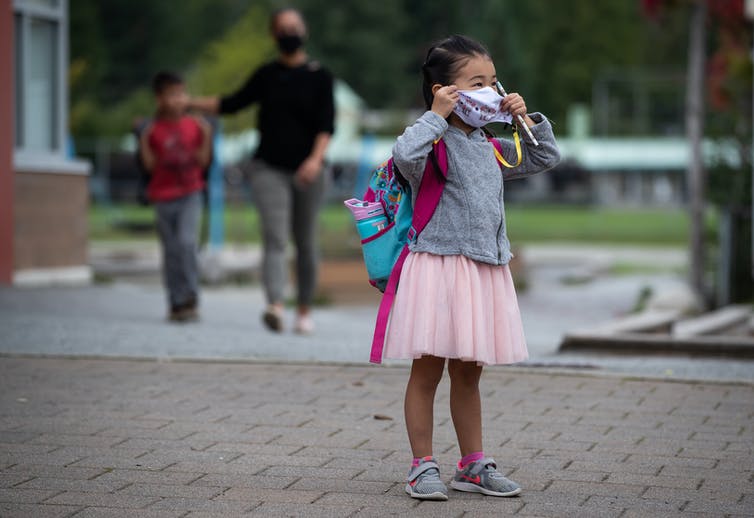Governments need more than just public health officials for COVID-19 lockdown advice
A health-care worker and volunteers watch as Ontario Premier Doug Ford visits a vaccine clinic for Purolator employees and their families at the company's plant in Toronto. THE CANADIAN PRESS/Chris Young
With many jurisdictions in another phase of pandemic-driven restrictions due to the Omicron COVID-19 wave, public opinion on COVID-19 containment measures tends to be divided and based on political ideology. This is a mistake.
School and business closures over the past two years demonstrate a failure of governance. As someone who studied the lessons of the 2008 global financial crisis, it is disheartening to see the same mistakes being made again.
Back then, governments abdicated their responsibility by prioritizing the opinions of financial industry professionals with technical mastery of complex algorithmic financial modelling tools. Now, they’re outsourcing their responsibilities to public health professionals with mastery of complex algorithmic epidemiological modelling tools.
Read more:
How regulatory agencies, not the courts, are imposing COVID-19 vaccine mandates
In interviewing local public health decision-makers, I learned that they had pushed for lockdowns during the previous SARS crisis and the bird flu, but government pushed back. In a pandemic, public health officers draw on functional training that allows them to employ sophisticated algorithmic modelling tools to assess epidemiological risk. However, they lack the tools to understand broader risks and harms.
To be clear, one important difference is that while financial industry professionals were motivated by greed, public health professionals are not. But the evidence shows their take on problem-solving is no different than any other manager. Past studies of risk management have shown that assessments are often limited to the variables managers are most comfortable with, overestimating the good their interventions do while underestimating the harm.
Governments need to work not just with experts in epidemiology, but psychology, business, education and community-building — anyone with a window into how we can assess the costs of lockdowns. And governments need to treat all advisers with equal skepticism.
Choosing between competing moral goods
As a business professor, I teach that capitalism relies upon government skepticism about corporate goals. We expect businesses to push for growth and limit competition. That’s why a healthy capitalist economy depends on governments pushing back with strong antitrust regulations.
Unfortunately, successive governments of all political stripes have been failing in this task. Their failures exacerbated the global crisis of 2008, and are now exacerbating the current crisis.
We expect public health officials to push for lockdowns as they focus on protecting their industry — preserving hospital capacity. In no uncertain terms, this is a moral and socially desirable good, aimed at saving lives by not overwhelming hospitals with COVID-19 cases.
But it’s not the only moral good, and attaining it is not without trade-offs. Our society has never explicitly debated whether the health-care industry is more important than other critical sectors, like education. Ontario Premier Doug Ford’s “it took me about 30 seconds to decide” comment justifying the latest school closures is problematic precisely for that reason. Privileging hospitals over schools may be the right call … but in a democracy, it should be debated.
We’ve seen evidence that some public health officials acknowledge the trade-offs in play. Remember the open letter signed by more than 1,000 public health professionals in the United States supporting Black Lives Matter protests in 2020 in the midst of COVID-19 lockdowns?
When signalling on an issue of social importance (racial justice) that health-care practitioners don’t have the tools to improve upon since they don’t control policing, it was apparently more reasonable to support easing lockdown restrictions than the social risk in entrenching a lockdown stance. That’s a pragmatic trade-off in the face of competing moral goods — one we can debate.
A similar logic is on display with masking guidance. We know more about the effectiveness of masking now than at the start of the crisis. Yet, public health officials have still encouraged the wearing of ineffective masks, even though there are harms. Masking children, for example, may have negative developmental implications.

A young girl puts on her face mask to curb the spread of COVID-19 as her parents drop her off at her elementary school in North Vancouver, B.C., in September 2021.
THE CANADIAN PRESS/Darryl Dyck
But the guidance signals a position on a divisive social issue, exemplified by Dr. Joshua Barocas, an American infectious diseases physician, who stated: “… wearing a mask can just be a symbol. It can show people that you are committed to the cause.”
Again, this stance is perfectly reasonable when considering the common good. But so is an opposing opinion. These are the types of debates government should be facilitating.
Proportionality and reciprocity
With the latest restrictions, Canadian public health officials are failing to meet their own ethical standards.
The public health ethics framework calls for “proportionality: potential benefits should be balanced against risks of harm.… If a limitation of rights, liberties or freedoms is deemed essential to achieve an intended goal, the least restrictive measures possible should be selected” and “reciprocity: those who are asked to take … greater or disproportionate burdens in order to protect the public good should be supported by society in doing so.…”
The harm associated with the closing of schools is impossible to enumerate. How are proportionality and reciprocity being enacted for our children? How are governments going to mitigate the damage to a generation of learners, the most vulnerable of whom may never catch up?
Which is to say nothing about the repeated targeting of certain industries, like hospitality, fitness and the arts, while others — including big box retail, private long-term care homes and major league sports — have been protected, largely due to government lobbying.

Hockey fans are seen at a game between the Toronto Maple Leafs and the Montréal Canadiens in Toronto in September 2021.
THE CANADIAN PRESS/Jon Blacker
The distinction between rule-makers and those who benefit from those rules has been difficult to maintain as changes in our public health environment became a destructive social and economic force.
Nonetheless, governments cannot simply promote public health officers to the position of rule-makers. Integrating health, business and social policy is a complex, multifaceted, long-term exercise. The protection and empowerment of citizens is a higher-order good which makes the freedom to create prosperity possible.
Governments need to learn from mistakes in past crises: don’t over-rely on lobbyists and those with the most complex algorithmic modelling tools. Bring a multitude of voices to the table and facilitate debate on what defines the common good. There is no lockdown severe enough, or stimulus generous enough, to assure that the society that emerges after the crisis will be an equitable and prosperous one.

David Weitzner receives funding from SSHRC.







